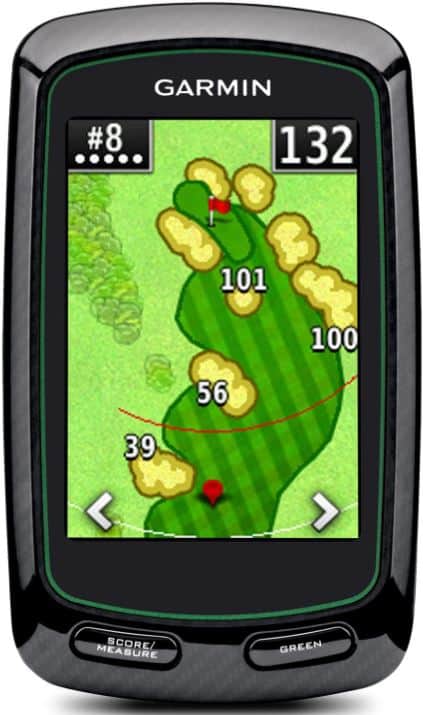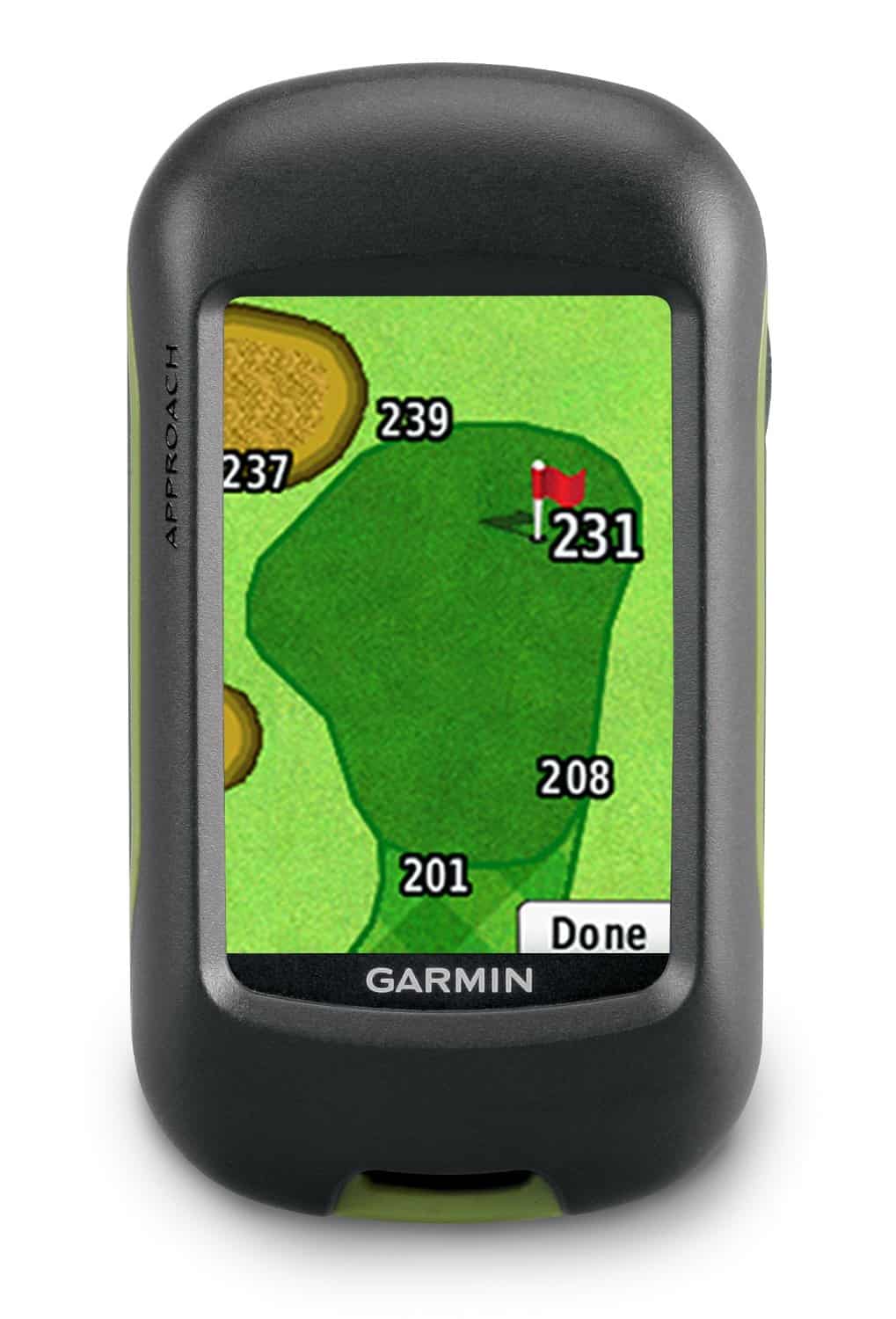The Garmin G80 handheld device is Garmin’s newest handheld golf GPS. It was released in January 2019. The Garmin Approach G80 has many improvements over the Garmin G8. The Garmin G80 has a bigger display area than the G8. Also the Garmin G80 has a better display resolution than the G8 and only the Garmin G80 has a radar-based launch monitor. However, the Garmin G80’s launch monitor lacks some of the features found in the best launch radars on the market, including the Swing Caddie SC300, Flightscope Mevo and Rapsodo. For example, the Garmin G80, SC300, and Mevo measure clubhead speed and ball speed but only the G80 does not measure spin rate.
The G80’s launch monitor is the feature that separates the Garmin G80 from other golf handhelds. This is the first time a handheld device contained both a golf GPS and launch monitor in one unit. The launch monitor uses the radar (which is an acronym radio detection and ranging) in the Garmin G80. There are numerous benefits to using a golf launch monitor including measuring ball flight and club data after ball impact. It also allows you to play a virtual round of golf on your favorite golf course.
Unfortunately, the Garmin G80’s launch monitor is not as sophisticated as the dedicated launch monitors from Swing Caddie, Flightscope and Rapsodo. This means that the Garmin G80 does not measure or calculate as much ball flight and club data as the more sophisticated dedicated launch monitors can. The ball flight and club data that the Garmin G80 can measure or calculate includes ball speed, club head speed, swing tempo, smash factor and carry distance. However, the Garmin G80 does not measure the ball spin rate, launch angle, ball directions, club face angle and club path angle. More information about the features missing in the Garmin G80 launch monitor is listed below.
Ball spin rate
The spin rate of a golf ball is the rate of rotation of the ball around its rotational axis immediately after it leaves the club face and is measured in revolutions per minute (RPM). The higher the spin rate, the higher the height but the lower the spin rate, the lower the height and the straighter it travels.
A golfer can increase their spin rate by hitting down on the golf ball with an open club face at impact. The impact creates a shock wave within the golf ball that is then transferred to the golf ball’s outer surface, causing it to spin. However, too much of a downwardly directed impact can cause a golf ball to have low initial velocity when it is initially struck which can cause the ball to “fly” abnormally low, even if the ball has a high spin rate.
Balls with more rotations per minute will create a more significant push-back effect for longer shots and can cause a golfer to lose accuracy. An amateur golfer will probably have a spin rate of 3200 RPM when hitting their drives while a PGA player will have a spin rate of 2700 RPM. The spin rate of a wedge is a lot higher, spinning at about 10000 RPM.
Launch angle
The golf launch angle is the angle between the ball’s initial trajectory after it leaves the clubface and the ground, expressed in degrees, and is related to the loft delivered at impact – the higher the loft, the higher the launch angle.
During a swing, the clubhead will travel on an arc from ball to target. The angle of this arc depends on various factors such as swing path, backswing shape, and loft of the club. For example, if an 8 iron has a loft of 24 degrees, then its relative golf launch angle would be about 33 degrees. These factors affect how far the ball travels downrange and how high it flies into the air.
A launch angle of zero degrees means the ball goes straight down and 90 degrees means the ball goes straight up. The ball has the greatest lift at the 90-degree angle, and the ball is inclined ever-so-slightly to the right (or to the left) for the 10-degree and 20-degree angles. The result is that the ball’s path is curving toward the right (or left) as it arcs around the oval, thus giving the illusion of a tight curve.
Most PGA golfers shoot for a launch angle of 10-12 degrees which is about halfway between a textbook pitching wedge and a full drive while the average golfer should aim for a launch angle of 14 degrees but different players may have different preferences. The goal of a golfer is to get a low spin rate and a high launch angle to produce a straight and long drive. A player can control this by changing their swing plane and pelvic tilt.
Club face angle
The club face angle is the angle between the target line (line from the ball to the target) and the club head’s face plane position. The club face angle is measured from a vertical plane that passes through the ball. This plane is usually perpendicular to the ground and passes through the center of the club head. In order to increase the accuracy of the golfer’s swing, it is desirable for the golfer to have a proper club face angle.
The club face angle is an important factor in determining how far your ball will go when you hit it. If you have a shallow club face angle, then your ball will travel less distance than if you had a deep club face angle. The club face is defined as the plane in which the face of the club is perpendicular to the ground. Most golfers choose to use a shallow club face angle. This assures a solid contact with the ball while still taking advantage of the low lofted clubs.
Club face angle varies depending on the type of shot being played, but typically ranges between 0° and 45°. The larger the club face angle, the more loft there is on the club, which means that shots will fly higher in the air. The larger club face angle also allows the club to head faster through the air, making it more difficult for the ball to be hit.
The club face angle at impact determines the direction of the ball off the tee. If the club face is aimed too low, the ball will fly to the right and if the face is aimed too high, the ball will fly to the left.
Club path angle
Club path angle is the angle of the club head relative to the ball at impact and the target line. A club path angle of 0° indicates that the club is moving perfectly down while a positive angle indicates the club is moving inside-out and a negative angle indicates it is moving from outside-in.
The position of the ball relative to the club face at impact will also help you determine whether the club face was moving from inside-out, outside-in, or perfectly down the line. The ideal angle of attack is between 5 and 8 degrees and it has a direct relationship to the swing plane angle which is a graphical representation of what a club face does as it moves through the swing. The swing plane is called a hinge axis in biomechanics.
The larger the angle of attack, the larger the swing plane angle. The larger the swing plane angle, the greater the length of the club head. The longer the club head, the farther the ball will travel.
The club path angle is determined by several factors, including the club’s lie angle and loft. Lie and loft affect the path of the club, and the lie angle and loft are determined by the golfer’s stance. The golf ball also may be lofted by the golfer before discharge from the golf club by hitting the ball with a club. The angle of the loft of the golf ball is typically measured by a golf club face angle gauge.
Apex (Maximum height)
A launch monitor calculates the maximum height of a golf shot by measuring the initial velocity and angle of the club head at impact. It also measures the ball’s vertical velocity and backspin, as well as its launch angle and carry distance.
The maximum height of a golf shot is determined by the loft of the club and clubhead speed. The higher the loft, the more a ball will spin, and the shorter the distance it will travel. You can change the loft of a club by switching shafts.
Ball flight time
The flight time of a golf ball is dependent on the initial velocity, angle of trajectory, atmospheric conditions, and the height of the tee. The following chart shows that for a standard driver. The time increases as the ball is hit further from the center of the face and at a greater angle. As for the distance, the distance is set by the height of the tee from the ground (the tee is placed at the mark where the ball should start) and the initial velocity of the ball. The initial velocity is usually taken from the club that the ball was hit with. The flight time and distance of the ball are also affected by the type of club. The longer the club, the higher the velocity it will impart to the ball, and the longer the flight time.
A launch monitor is a device that measures the speed and trajectory of a golf ball. The data collected from the launch monitor is used to calculate the time in flight, which is the time it takes for a golf ball to travel from its starting point to its landing point.
This is a difficult question to answer because there are so many variables. A golf ball’s flight time will vary depending on the club used, if it is hit with backspin or not, how hard it was hit, and the surface of the ground.
If you ignore the dimples of the ball, you can get a rough estimate of the flight time of a golf ball by using the equation:
t = (vf- vi)/g where vf is the final velocity, vi is the initial velocity, and g is the acceleration
The initial velocity is most often given as a golfer’s club head speed, which is measured in miles per hour. To calculate the final velocity, you must know how far away from the tee box that the ball landed.
You can use the following equation to calculate the final velocity:
vf = sqrt((vi*vi) + 2gd) where vf is the final velocity, vi is the initial velocity, g is the acceleration and d is the horizontal distance where the ball landed.



